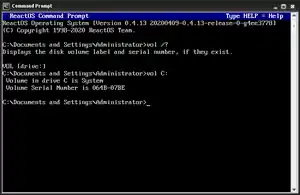vol (command)
In some operating systems, vol is a command within the command-line interpreters (shells) such as COMMAND.COM and cmd.exe. It is used to display the volume label and volume serial number of a logical drive, such as a hard disk partition or a floppy disk, if they exist.[1]
 The Windows XP vol command | |
| Developer(s) | DR, Microsoft, IBM, Toshiba, ReactOS Contributors |
|---|---|
| Initial release | March 1983 |
| Operating system | MS-DOS, PC DOS, MSX-DOS, FlexOS, SISNE plus, OS/2, eComStation, ArcaOS, DR DOS, ROM-DOS, 4690 OS, PTS-DOS, Windows, FreeDOS, ReactOS |
| Platform | Cross-platform |
| Type | Command |
Implementations

vol commandThe command is available in various versions of DOS,[2] DR FlexOS,[3] IBM/Toshiba 4690 OS,[4] IBM OS/2,[5] Microsoft Windows,[6] and ReactOS.[7]
On MS-DOS, the command is available in versions 2 and later.[8] Paragon Technology Systems PTS-DOS 2000 Pro also includes a vol implementation.[9]
The Windows dir command also displays the volume label and serial number (if it has one) as part of the directory listing.
Syntax
vol [Drive:]
Arguments:
Drive:This command-line argument specifies the drive letter of the disk for which to display the volume label and serial number.
Note:
- On Windows, the volume serial number is displayed only for disks formatted with MS-DOS version 4.0 or later.
- OS/2 allows the user to specify more than one drive. The
volcommand displays the volume labels consecutively.
Examples
IBM OS/2
[C:\]vol C:
The volume label in drive C is OS/2.
The Volume Serial Number is 0815:1611.
Microsoft Windows
C:\Users\root>vol C:
Volume in drive C is Windows
Volume Serial Number is 080F-100B
In the example above, if drive C: has no volume label, "has no label" is shown instead of "is Windows".
See also
| Wikibooks has a book on the topic of: Guide to Windows Commands |
- Label (command) — Used to create, change and delete the disk volume label.
- List of DOS commands
References
- MS-DOS and Windows command line vol command
- Jamsa, Kris A. (1993), DOS: The Complete Reference, Osborne McGraw-Hill, ISBN 0078819040.
- http://www.bitsavers.org/pdf/digitalResearch/flexos/1073-2003_FlexOS_Users_Guide_V1.3_Nov86.pdf
- https://archive.org/details/4690OSV6r2UsersGuide/page/n169
- http://www.jatomes.com/Help/Os2Cmd.php#VOL
- Microsoft TechNet Vol article
- https://github.com/reactos/reactos/blob/master/base/shell/cmd/vol.c
- Wolverton, Van (2003). Running MS-DOS Version 6.22 (20th Anniversary Edition), 6th Revised edition. Microsoft Press. ISBN 0-7356-1812-7.
- "PTS-DOS 2000 Pro User Manual" (PDF). Buggingen, Germany: Paragon Technology GmbH. 1999. Archived (PDF) from the original on 2018-05-12. Retrieved 2018-05-12.
- "EFI Shells and Scripting". Intel. Retrieved 2013-09-25.
Further reading
- Cooper, Jim (2001). Special Edition Using MS-DOS 6.22, Third Edition. Que Publishing. ISBN 978-0789725738.
- Tim O'Reilly; Troy Mott; Walter Glenn (1999). Windows 98 in a Nutshell: A Desktop Quick Reference. O'Reilly. ISBN 978-1565924864.
- John Paul Mueller (2007). Windows Administration at the Command Line for Windows Vista, Windows 2003, Windows XP, and Windows 2000. John Wiley & Sons. ISBN 978-0470165799.